Management Research Report: Systematic Review, Strategies & Methods
VerifiedAdded on 2023/01/12
|10
|3010
|60
Report
AI Summary
This report provides a comprehensive overview of management research, beginning with an introduction to the concept and its importance for effective business operations. The main body delves into the definition and process of systematic reviews of academic literature, emphasizing their role in assessing data quality and research authenticity. It identifies various qualitative research strategies, such as focus groups, participant observation, and in-depth interviews, and explains their applications in business and management research. Furthermore, the report compares and contrasts different types of mixed methods research, including triangulation and embedded design, highlighting their uses in business and management contexts. The report concludes by summarizing the key findings and emphasizing the significance of research in informed decision-making. The content is designed to help students understand the practical application of research methodologies in the field of management.
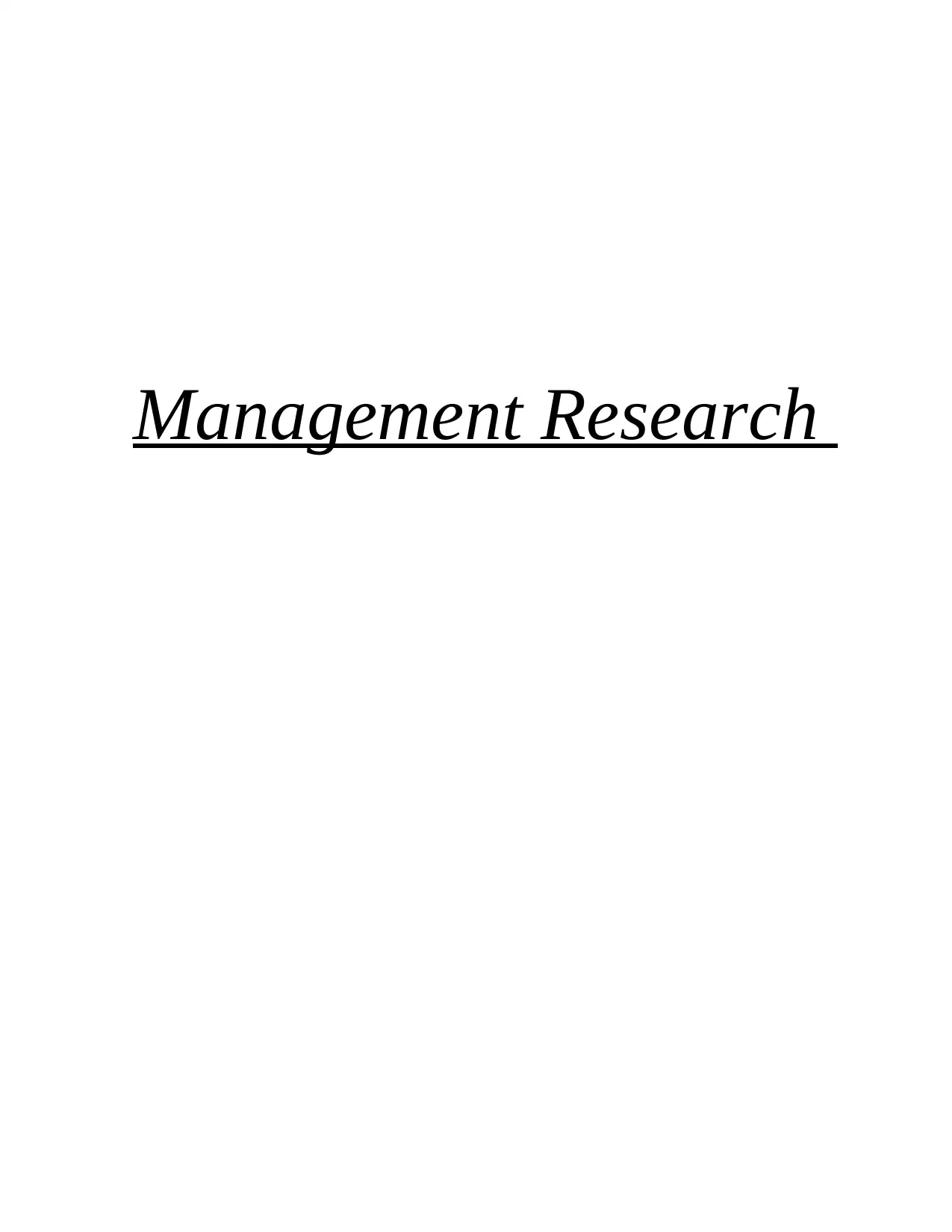
Management Research
Paraphrase This Document
Need a fresh take? Get an instant paraphrase of this document with our AI Paraphraser
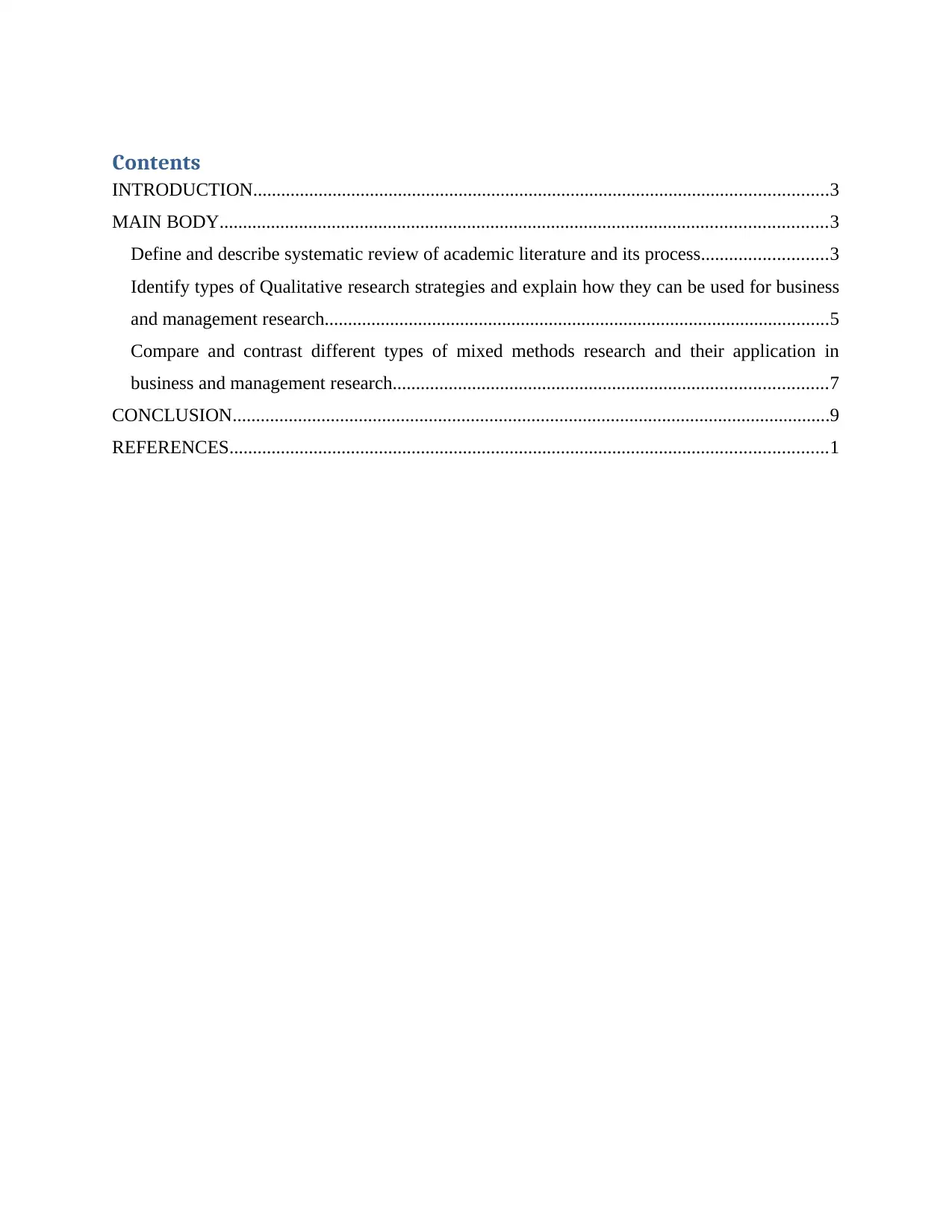
Contents
INTRODUCTION...........................................................................................................................3
MAIN BODY..................................................................................................................................3
Define and describe systematic review of academic literature and its process...........................3
Identify types of Qualitative research strategies and explain how they can be used for business
and management research............................................................................................................5
Compare and contrast different types of mixed methods research and their application in
business and management research.............................................................................................7
CONCLUSION................................................................................................................................9
REFERENCES................................................................................................................................1
INTRODUCTION...........................................................................................................................3
MAIN BODY..................................................................................................................................3
Define and describe systematic review of academic literature and its process...........................3
Identify types of Qualitative research strategies and explain how they can be used for business
and management research............................................................................................................5
Compare and contrast different types of mixed methods research and their application in
business and management research.............................................................................................7
CONCLUSION................................................................................................................................9
REFERENCES................................................................................................................................1
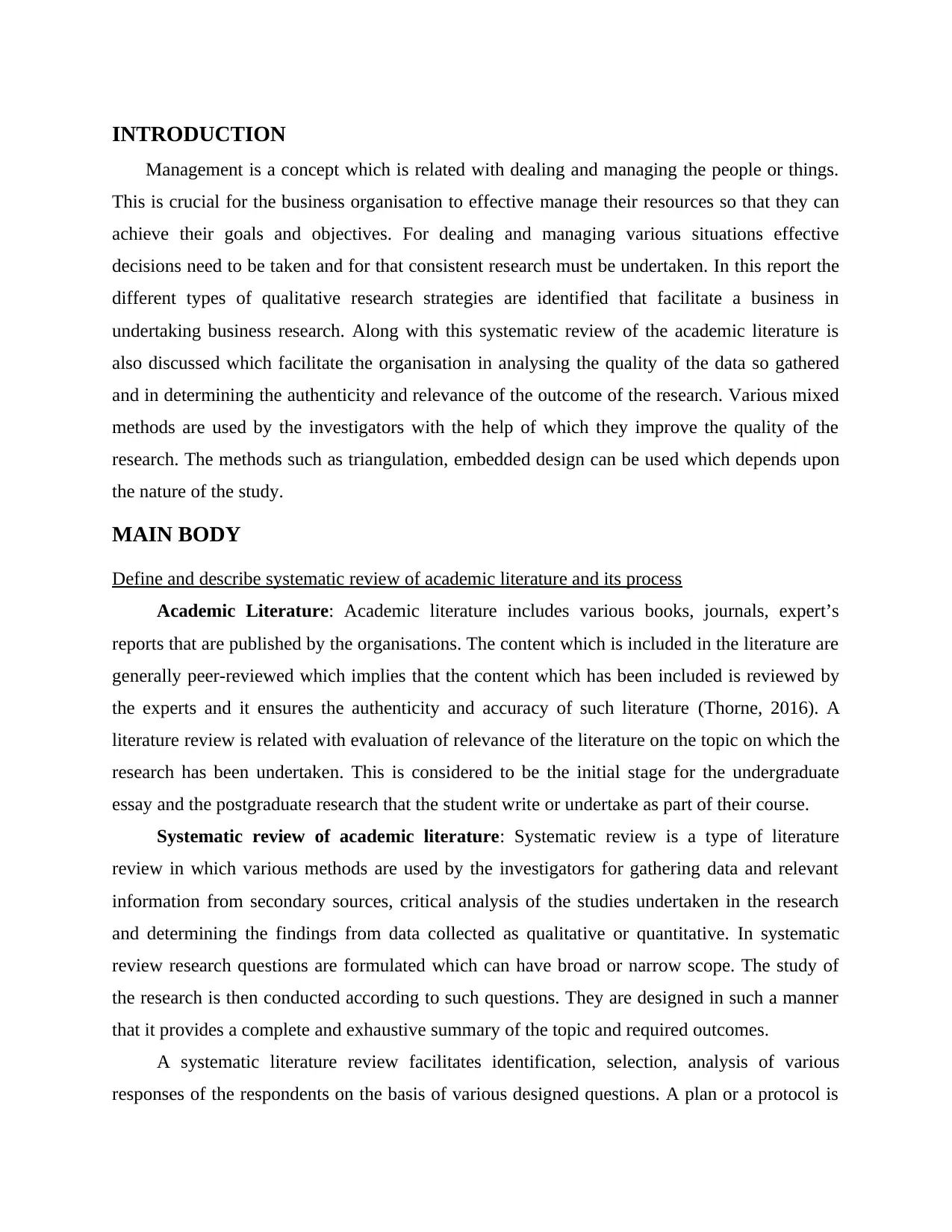
INTRODUCTION
Management is a concept which is related with dealing and managing the people or things.
This is crucial for the business organisation to effective manage their resources so that they can
achieve their goals and objectives. For dealing and managing various situations effective
decisions need to be taken and for that consistent research must be undertaken. In this report the
different types of qualitative research strategies are identified that facilitate a business in
undertaking business research. Along with this systematic review of the academic literature is
also discussed which facilitate the organisation in analysing the quality of the data so gathered
and in determining the authenticity and relevance of the outcome of the research. Various mixed
methods are used by the investigators with the help of which they improve the quality of the
research. The methods such as triangulation, embedded design can be used which depends upon
the nature of the study.
MAIN BODY
Define and describe systematic review of academic literature and its process
Academic Literature: Academic literature includes various books, journals, expert’s
reports that are published by the organisations. The content which is included in the literature are
generally peer-reviewed which implies that the content which has been included is reviewed by
the experts and it ensures the authenticity and accuracy of such literature (Thorne, 2016). A
literature review is related with evaluation of relevance of the literature on the topic on which the
research has been undertaken. This is considered to be the initial stage for the undergraduate
essay and the postgraduate research that the student write or undertake as part of their course.
Systematic review of academic literature: Systematic review is a type of literature
review in which various methods are used by the investigators for gathering data and relevant
information from secondary sources, critical analysis of the studies undertaken in the research
and determining the findings from data collected as qualitative or quantitative. In systematic
review research questions are formulated which can have broad or narrow scope. The study of
the research is then conducted according to such questions. They are designed in such a manner
that it provides a complete and exhaustive summary of the topic and required outcomes.
A systematic literature review facilitates identification, selection, analysis of various
responses of the respondents on the basis of various designed questions. A plan or a protocol is
Management is a concept which is related with dealing and managing the people or things.
This is crucial for the business organisation to effective manage their resources so that they can
achieve their goals and objectives. For dealing and managing various situations effective
decisions need to be taken and for that consistent research must be undertaken. In this report the
different types of qualitative research strategies are identified that facilitate a business in
undertaking business research. Along with this systematic review of the academic literature is
also discussed which facilitate the organisation in analysing the quality of the data so gathered
and in determining the authenticity and relevance of the outcome of the research. Various mixed
methods are used by the investigators with the help of which they improve the quality of the
research. The methods such as triangulation, embedded design can be used which depends upon
the nature of the study.
MAIN BODY
Define and describe systematic review of academic literature and its process
Academic Literature: Academic literature includes various books, journals, expert’s
reports that are published by the organisations. The content which is included in the literature are
generally peer-reviewed which implies that the content which has been included is reviewed by
the experts and it ensures the authenticity and accuracy of such literature (Thorne, 2016). A
literature review is related with evaluation of relevance of the literature on the topic on which the
research has been undertaken. This is considered to be the initial stage for the undergraduate
essay and the postgraduate research that the student write or undertake as part of their course.
Systematic review of academic literature: Systematic review is a type of literature
review in which various methods are used by the investigators for gathering data and relevant
information from secondary sources, critical analysis of the studies undertaken in the research
and determining the findings from data collected as qualitative or quantitative. In systematic
review research questions are formulated which can have broad or narrow scope. The study of
the research is then conducted according to such questions. They are designed in such a manner
that it provides a complete and exhaustive summary of the topic and required outcomes.
A systematic literature review facilitates identification, selection, analysis of various
responses of the respondents on the basis of various designed questions. A plan or a protocol is
⊘ This is a preview!⊘
Do you want full access?
Subscribe today to unlock all pages.

Trusted by 1+ million students worldwide
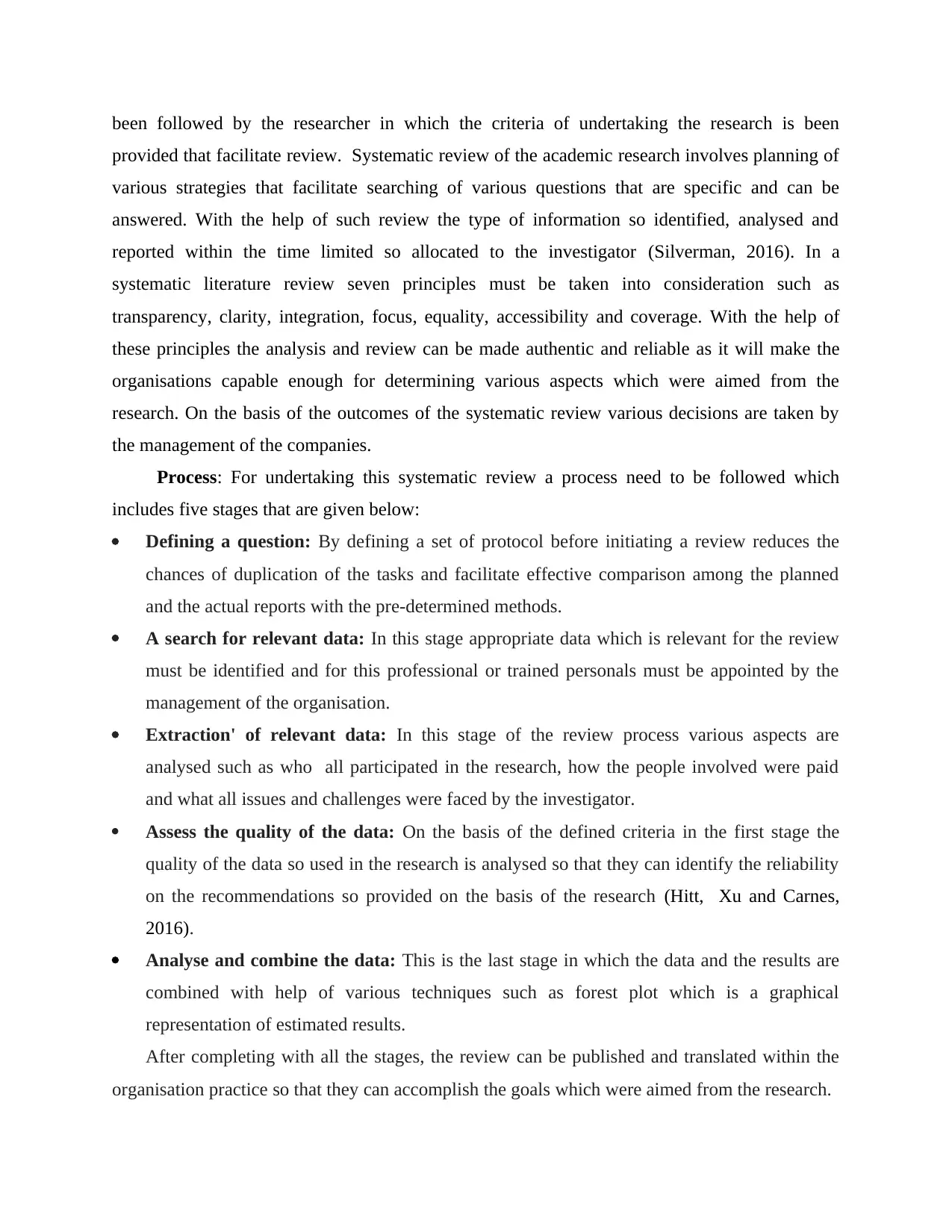
been followed by the researcher in which the criteria of undertaking the research is been
provided that facilitate review. Systematic review of the academic research involves planning of
various strategies that facilitate searching of various questions that are specific and can be
answered. With the help of such review the type of information so identified, analysed and
reported within the time limited so allocated to the investigator (Silverman, 2016). In a
systematic literature review seven principles must be taken into consideration such as
transparency, clarity, integration, focus, equality, accessibility and coverage. With the help of
these principles the analysis and review can be made authentic and reliable as it will make the
organisations capable enough for determining various aspects which were aimed from the
research. On the basis of the outcomes of the systematic review various decisions are taken by
the management of the companies.
Process: For undertaking this systematic review a process need to be followed which
includes five stages that are given below:
Defining a question: By defining a set of protocol before initiating a review reduces the
chances of duplication of the tasks and facilitate effective comparison among the planned
and the actual reports with the pre-determined methods.
A search for relevant data: In this stage appropriate data which is relevant for the review
must be identified and for this professional or trained personals must be appointed by the
management of the organisation.
Extraction' of relevant data: In this stage of the review process various aspects are
analysed such as who all participated in the research, how the people involved were paid
and what all issues and challenges were faced by the investigator.
Assess the quality of the data: On the basis of the defined criteria in the first stage the
quality of the data so used in the research is analysed so that they can identify the reliability
on the recommendations so provided on the basis of the research (Hitt, Xu and Carnes,
2016).
Analyse and combine the data: This is the last stage in which the data and the results are
combined with help of various techniques such as forest plot which is a graphical
representation of estimated results.
After completing with all the stages, the review can be published and translated within the
organisation practice so that they can accomplish the goals which were aimed from the research.
provided that facilitate review. Systematic review of the academic research involves planning of
various strategies that facilitate searching of various questions that are specific and can be
answered. With the help of such review the type of information so identified, analysed and
reported within the time limited so allocated to the investigator (Silverman, 2016). In a
systematic literature review seven principles must be taken into consideration such as
transparency, clarity, integration, focus, equality, accessibility and coverage. With the help of
these principles the analysis and review can be made authentic and reliable as it will make the
organisations capable enough for determining various aspects which were aimed from the
research. On the basis of the outcomes of the systematic review various decisions are taken by
the management of the companies.
Process: For undertaking this systematic review a process need to be followed which
includes five stages that are given below:
Defining a question: By defining a set of protocol before initiating a review reduces the
chances of duplication of the tasks and facilitate effective comparison among the planned
and the actual reports with the pre-determined methods.
A search for relevant data: In this stage appropriate data which is relevant for the review
must be identified and for this professional or trained personals must be appointed by the
management of the organisation.
Extraction' of relevant data: In this stage of the review process various aspects are
analysed such as who all participated in the research, how the people involved were paid
and what all issues and challenges were faced by the investigator.
Assess the quality of the data: On the basis of the defined criteria in the first stage the
quality of the data so used in the research is analysed so that they can identify the reliability
on the recommendations so provided on the basis of the research (Hitt, Xu and Carnes,
2016).
Analyse and combine the data: This is the last stage in which the data and the results are
combined with help of various techniques such as forest plot which is a graphical
representation of estimated results.
After completing with all the stages, the review can be published and translated within the
organisation practice so that they can accomplish the goals which were aimed from the research.
Paraphrase This Document
Need a fresh take? Get an instant paraphrase of this document with our AI Paraphraser
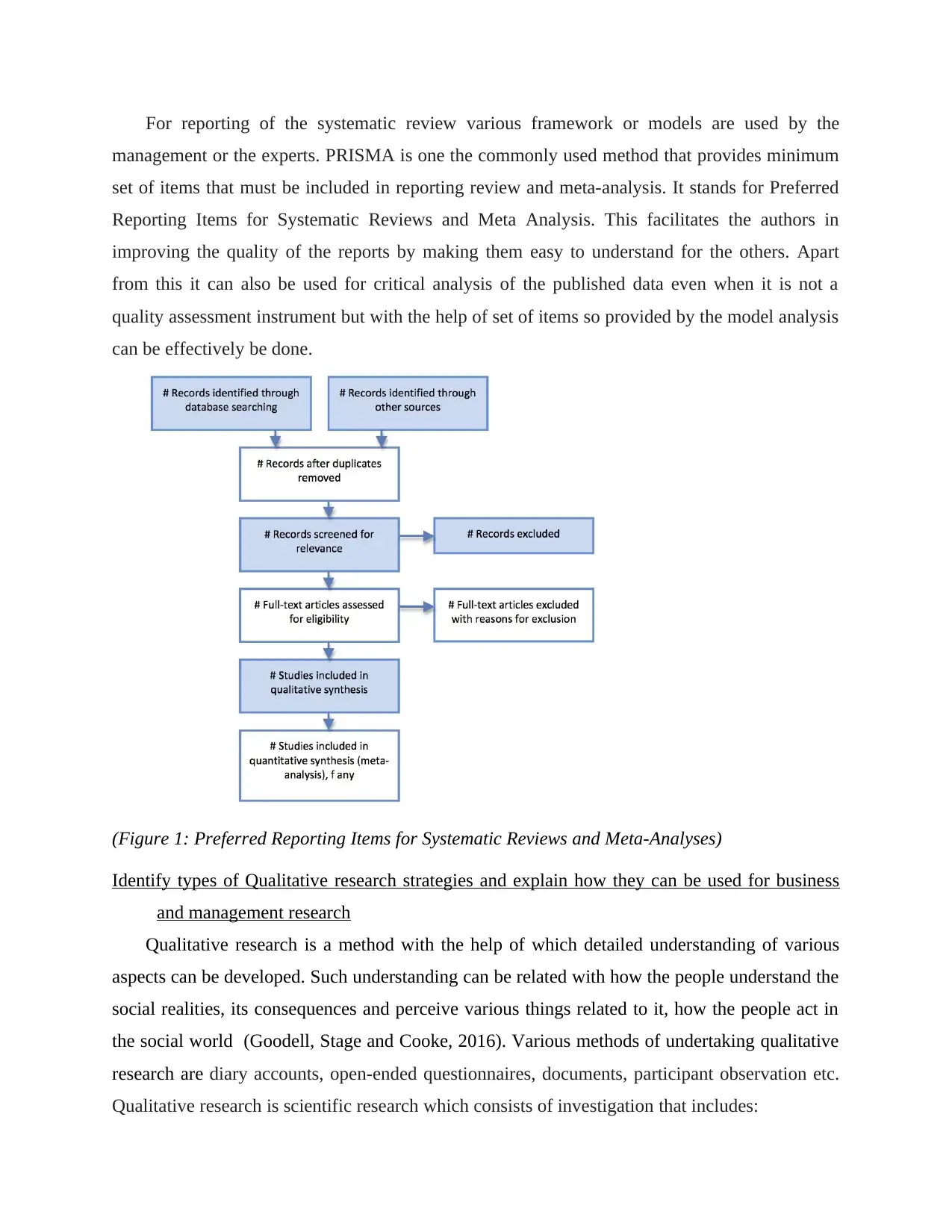
For reporting of the systematic review various framework or models are used by the
management or the experts. PRISMA is one the commonly used method that provides minimum
set of items that must be included in reporting review and meta-analysis. It stands for Preferred
Reporting Items for Systematic Reviews and Meta Analysis. This facilitates the authors in
improving the quality of the reports by making them easy to understand for the others. Apart
from this it can also be used for critical analysis of the published data even when it is not a
quality assessment instrument but with the help of set of items so provided by the model analysis
can be effectively be done.
(Figure 1: Preferred Reporting Items for Systematic Reviews and Meta-Analyses)
Identify types of Qualitative research strategies and explain how they can be used for business
and management research
Qualitative research is a method with the help of which detailed understanding of various
aspects can be developed. Such understanding can be related with how the people understand the
social realities, its consequences and perceive various things related to it, how the people act in
the social world (Goodell, Stage and Cooke, 2016). Various methods of undertaking qualitative
research are diary accounts, open-ended questionnaires, documents, participant observation etc.
Qualitative research is scientific research which consists of investigation that includes:
management or the experts. PRISMA is one the commonly used method that provides minimum
set of items that must be included in reporting review and meta-analysis. It stands for Preferred
Reporting Items for Systematic Reviews and Meta Analysis. This facilitates the authors in
improving the quality of the reports by making them easy to understand for the others. Apart
from this it can also be used for critical analysis of the published data even when it is not a
quality assessment instrument but with the help of set of items so provided by the model analysis
can be effectively be done.
(Figure 1: Preferred Reporting Items for Systematic Reviews and Meta-Analyses)
Identify types of Qualitative research strategies and explain how they can be used for business
and management research
Qualitative research is a method with the help of which detailed understanding of various
aspects can be developed. Such understanding can be related with how the people understand the
social realities, its consequences and perceive various things related to it, how the people act in
the social world (Goodell, Stage and Cooke, 2016). Various methods of undertaking qualitative
research are diary accounts, open-ended questionnaires, documents, participant observation etc.
Qualitative research is scientific research which consists of investigation that includes:
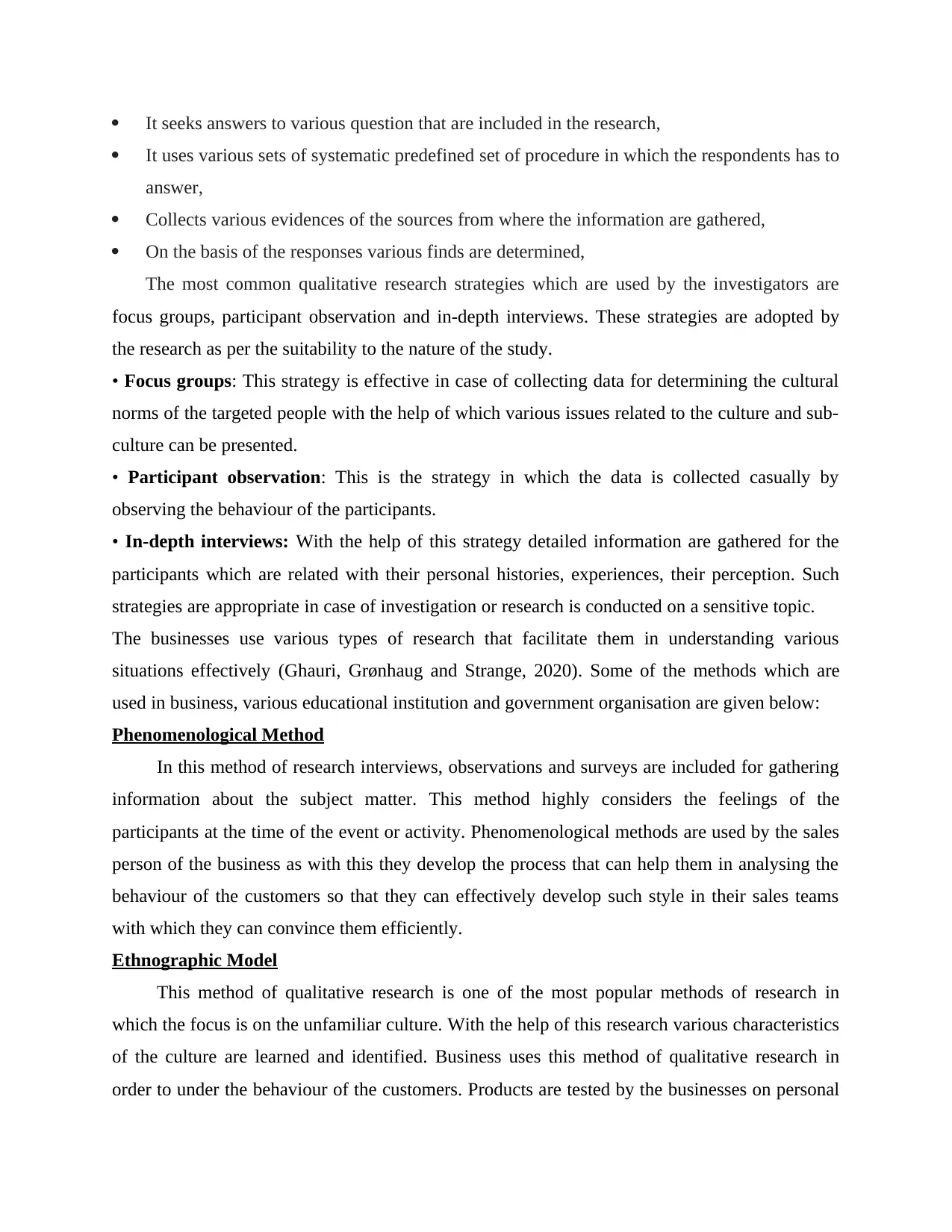
It seeks answers to various question that are included in the research,
It uses various sets of systematic predefined set of procedure in which the respondents has to
answer,
Collects various evidences of the sources from where the information are gathered,
On the basis of the responses various finds are determined,
The most common qualitative research strategies which are used by the investigators are
focus groups, participant observation and in-depth interviews. These strategies are adopted by
the research as per the suitability to the nature of the study.
• Focus groups: This strategy is effective in case of collecting data for determining the cultural
norms of the targeted people with the help of which various issues related to the culture and sub-
culture can be presented.
• Participant observation: This is the strategy in which the data is collected casually by
observing the behaviour of the participants.
• In-depth interviews: With the help of this strategy detailed information are gathered for the
participants which are related with their personal histories, experiences, their perception. Such
strategies are appropriate in case of investigation or research is conducted on a sensitive topic.
The businesses use various types of research that facilitate them in understanding various
situations effectively (Ghauri, Grønhaug and Strange, 2020). Some of the methods which are
used in business, various educational institution and government organisation are given below:
Phenomenological Method
In this method of research interviews, observations and surveys are included for gathering
information about the subject matter. This method highly considers the feelings of the
participants at the time of the event or activity. Phenomenological methods are used by the sales
person of the business as with this they develop the process that can help them in analysing the
behaviour of the customers so that they can effectively develop such style in their sales teams
with which they can convince them efficiently.
Ethnographic Model
This method of qualitative research is one of the most popular methods of research in
which the focus is on the unfamiliar culture. With the help of this research various characteristics
of the culture are learned and identified. Business uses this method of qualitative research in
order to under the behaviour of the customers. Products are tested by the businesses on personal
It uses various sets of systematic predefined set of procedure in which the respondents has to
answer,
Collects various evidences of the sources from where the information are gathered,
On the basis of the responses various finds are determined,
The most common qualitative research strategies which are used by the investigators are
focus groups, participant observation and in-depth interviews. These strategies are adopted by
the research as per the suitability to the nature of the study.
• Focus groups: This strategy is effective in case of collecting data for determining the cultural
norms of the targeted people with the help of which various issues related to the culture and sub-
culture can be presented.
• Participant observation: This is the strategy in which the data is collected casually by
observing the behaviour of the participants.
• In-depth interviews: With the help of this strategy detailed information are gathered for the
participants which are related with their personal histories, experiences, their perception. Such
strategies are appropriate in case of investigation or research is conducted on a sensitive topic.
The businesses use various types of research that facilitate them in understanding various
situations effectively (Ghauri, Grønhaug and Strange, 2020). Some of the methods which are
used in business, various educational institution and government organisation are given below:
Phenomenological Method
In this method of research interviews, observations and surveys are included for gathering
information about the subject matter. This method highly considers the feelings of the
participants at the time of the event or activity. Phenomenological methods are used by the sales
person of the business as with this they develop the process that can help them in analysing the
behaviour of the customers so that they can effectively develop such style in their sales teams
with which they can convince them efficiently.
Ethnographic Model
This method of qualitative research is one of the most popular methods of research in
which the focus is on the unfamiliar culture. With the help of this research various characteristics
of the culture are learned and identified. Business uses this method of qualitative research in
order to under the behaviour of the customers. Products are tested by the businesses on personal
⊘ This is a preview!⊘
Do you want full access?
Subscribe today to unlock all pages.

Trusted by 1+ million students worldwide
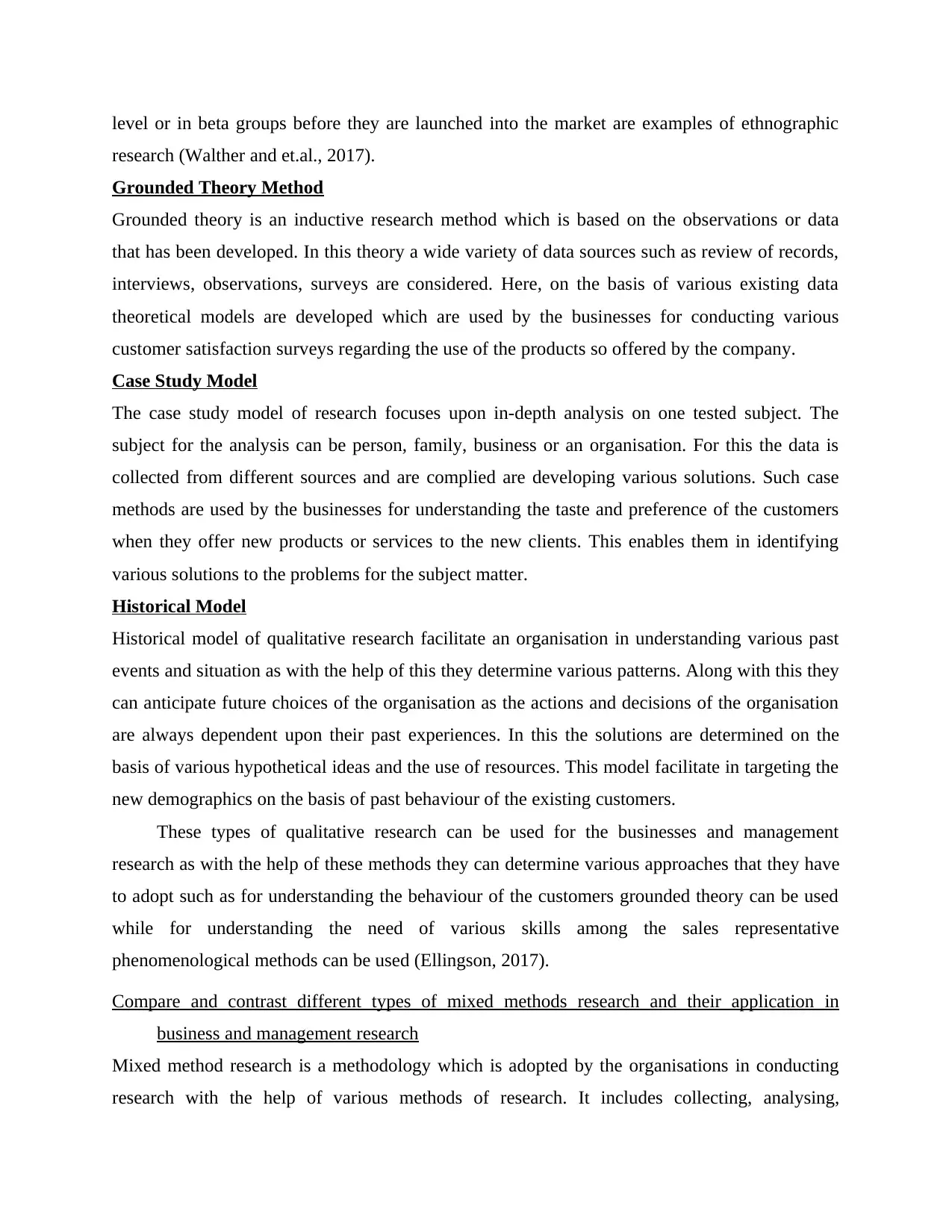
level or in beta groups before they are launched into the market are examples of ethnographic
research (Walther and et.al., 2017).
Grounded Theory Method
Grounded theory is an inductive research method which is based on the observations or data
that has been developed. In this theory a wide variety of data sources such as review of records,
interviews, observations, surveys are considered. Here, on the basis of various existing data
theoretical models are developed which are used by the businesses for conducting various
customer satisfaction surveys regarding the use of the products so offered by the company.
Case Study Model
The case study model of research focuses upon in-depth analysis on one tested subject. The
subject for the analysis can be person, family, business or an organisation. For this the data is
collected from different sources and are complied are developing various solutions. Such case
methods are used by the businesses for understanding the taste and preference of the customers
when they offer new products or services to the new clients. This enables them in identifying
various solutions to the problems for the subject matter.
Historical Model
Historical model of qualitative research facilitate an organisation in understanding various past
events and situation as with the help of this they determine various patterns. Along with this they
can anticipate future choices of the organisation as the actions and decisions of the organisation
are always dependent upon their past experiences. In this the solutions are determined on the
basis of various hypothetical ideas and the use of resources. This model facilitate in targeting the
new demographics on the basis of past behaviour of the existing customers.
These types of qualitative research can be used for the businesses and management
research as with the help of these methods they can determine various approaches that they have
to adopt such as for understanding the behaviour of the customers grounded theory can be used
while for understanding the need of various skills among the sales representative
phenomenological methods can be used (Ellingson, 2017).
Compare and contrast different types of mixed methods research and their application in
business and management research
Mixed method research is a methodology which is adopted by the organisations in conducting
research with the help of various methods of research. It includes collecting, analysing,
research (Walther and et.al., 2017).
Grounded Theory Method
Grounded theory is an inductive research method which is based on the observations or data
that has been developed. In this theory a wide variety of data sources such as review of records,
interviews, observations, surveys are considered. Here, on the basis of various existing data
theoretical models are developed which are used by the businesses for conducting various
customer satisfaction surveys regarding the use of the products so offered by the company.
Case Study Model
The case study model of research focuses upon in-depth analysis on one tested subject. The
subject for the analysis can be person, family, business or an organisation. For this the data is
collected from different sources and are complied are developing various solutions. Such case
methods are used by the businesses for understanding the taste and preference of the customers
when they offer new products or services to the new clients. This enables them in identifying
various solutions to the problems for the subject matter.
Historical Model
Historical model of qualitative research facilitate an organisation in understanding various past
events and situation as with the help of this they determine various patterns. Along with this they
can anticipate future choices of the organisation as the actions and decisions of the organisation
are always dependent upon their past experiences. In this the solutions are determined on the
basis of various hypothetical ideas and the use of resources. This model facilitate in targeting the
new demographics on the basis of past behaviour of the existing customers.
These types of qualitative research can be used for the businesses and management
research as with the help of these methods they can determine various approaches that they have
to adopt such as for understanding the behaviour of the customers grounded theory can be used
while for understanding the need of various skills among the sales representative
phenomenological methods can be used (Ellingson, 2017).
Compare and contrast different types of mixed methods research and their application in
business and management research
Mixed method research is a methodology which is adopted by the organisations in conducting
research with the help of various methods of research. It includes collecting, analysing,
Paraphrase This Document
Need a fresh take? Get an instant paraphrase of this document with our AI Paraphraser
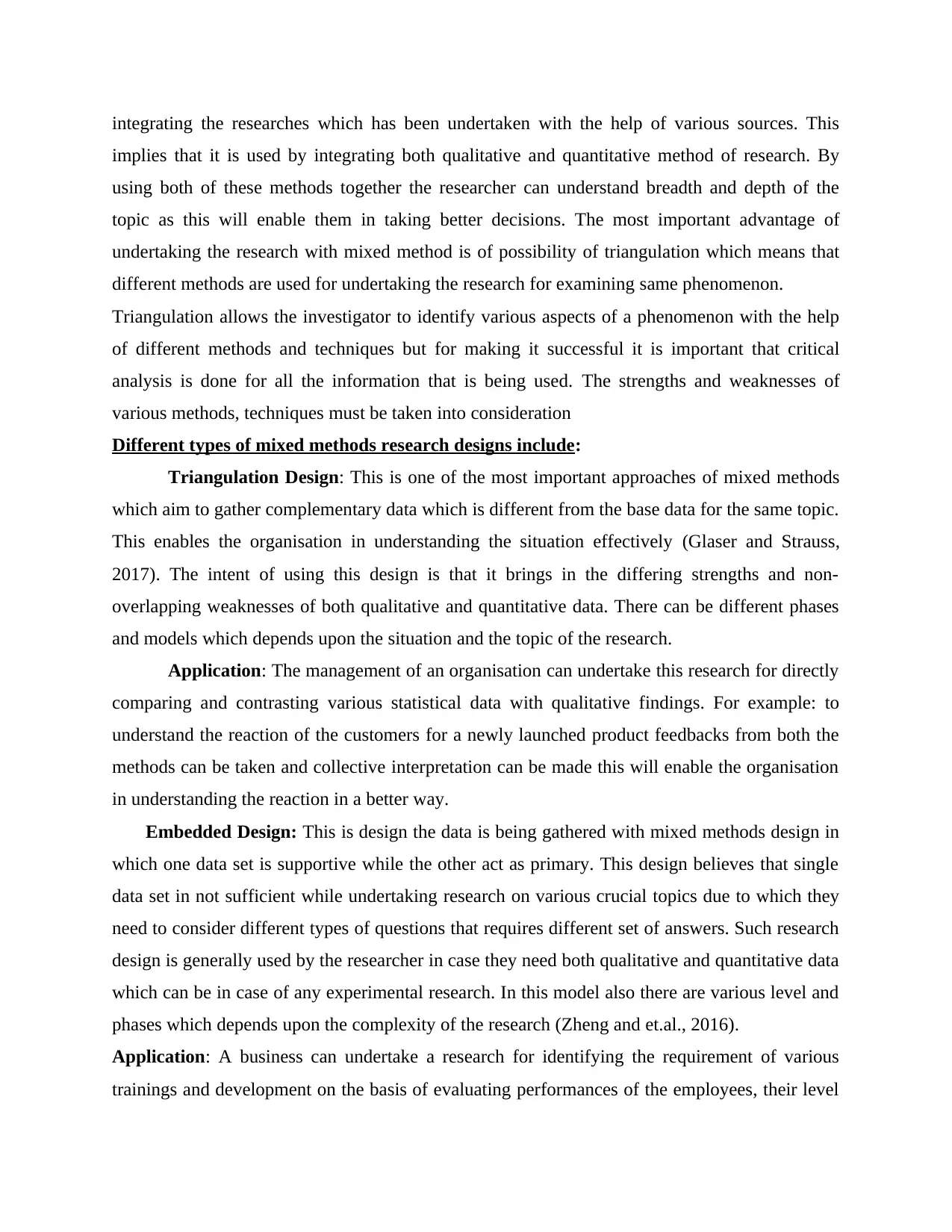
integrating the researches which has been undertaken with the help of various sources. This
implies that it is used by integrating both qualitative and quantitative method of research. By
using both of these methods together the researcher can understand breadth and depth of the
topic as this will enable them in taking better decisions. The most important advantage of
undertaking the research with mixed method is of possibility of triangulation which means that
different methods are used for undertaking the research for examining same phenomenon.
Triangulation allows the investigator to identify various aspects of a phenomenon with the help
of different methods and techniques but for making it successful it is important that critical
analysis is done for all the information that is being used. The strengths and weaknesses of
various methods, techniques must be taken into consideration
Different types of mixed methods research designs include:
Triangulation Design: This is one of the most important approaches of mixed methods
which aim to gather complementary data which is different from the base data for the same topic.
This enables the organisation in understanding the situation effectively (Glaser and Strauss,
2017). The intent of using this design is that it brings in the differing strengths and non-
overlapping weaknesses of both qualitative and quantitative data. There can be different phases
and models which depends upon the situation and the topic of the research.
Application: The management of an organisation can undertake this research for directly
comparing and contrasting various statistical data with qualitative findings. For example: to
understand the reaction of the customers for a newly launched product feedbacks from both the
methods can be taken and collective interpretation can be made this will enable the organisation
in understanding the reaction in a better way.
Embedded Design: This is design the data is being gathered with mixed methods design in
which one data set is supportive while the other act as primary. This design believes that single
data set in not sufficient while undertaking research on various crucial topics due to which they
need to consider different types of questions that requires different set of answers. Such research
design is generally used by the researcher in case they need both qualitative and quantitative data
which can be in case of any experimental research. In this model also there are various level and
phases which depends upon the complexity of the research (Zheng and et.al., 2016).
Application: A business can undertake a research for identifying the requirement of various
trainings and development on the basis of evaluating performances of the employees, their level
implies that it is used by integrating both qualitative and quantitative method of research. By
using both of these methods together the researcher can understand breadth and depth of the
topic as this will enable them in taking better decisions. The most important advantage of
undertaking the research with mixed method is of possibility of triangulation which means that
different methods are used for undertaking the research for examining same phenomenon.
Triangulation allows the investigator to identify various aspects of a phenomenon with the help
of different methods and techniques but for making it successful it is important that critical
analysis is done for all the information that is being used. The strengths and weaknesses of
various methods, techniques must be taken into consideration
Different types of mixed methods research designs include:
Triangulation Design: This is one of the most important approaches of mixed methods
which aim to gather complementary data which is different from the base data for the same topic.
This enables the organisation in understanding the situation effectively (Glaser and Strauss,
2017). The intent of using this design is that it brings in the differing strengths and non-
overlapping weaknesses of both qualitative and quantitative data. There can be different phases
and models which depends upon the situation and the topic of the research.
Application: The management of an organisation can undertake this research for directly
comparing and contrasting various statistical data with qualitative findings. For example: to
understand the reaction of the customers for a newly launched product feedbacks from both the
methods can be taken and collective interpretation can be made this will enable the organisation
in understanding the reaction in a better way.
Embedded Design: This is design the data is being gathered with mixed methods design in
which one data set is supportive while the other act as primary. This design believes that single
data set in not sufficient while undertaking research on various crucial topics due to which they
need to consider different types of questions that requires different set of answers. Such research
design is generally used by the researcher in case they need both qualitative and quantitative data
which can be in case of any experimental research. In this model also there are various level and
phases which depends upon the complexity of the research (Zheng and et.al., 2016).
Application: A business can undertake a research for identifying the requirement of various
trainings and development on the basis of evaluating performances of the employees, their level
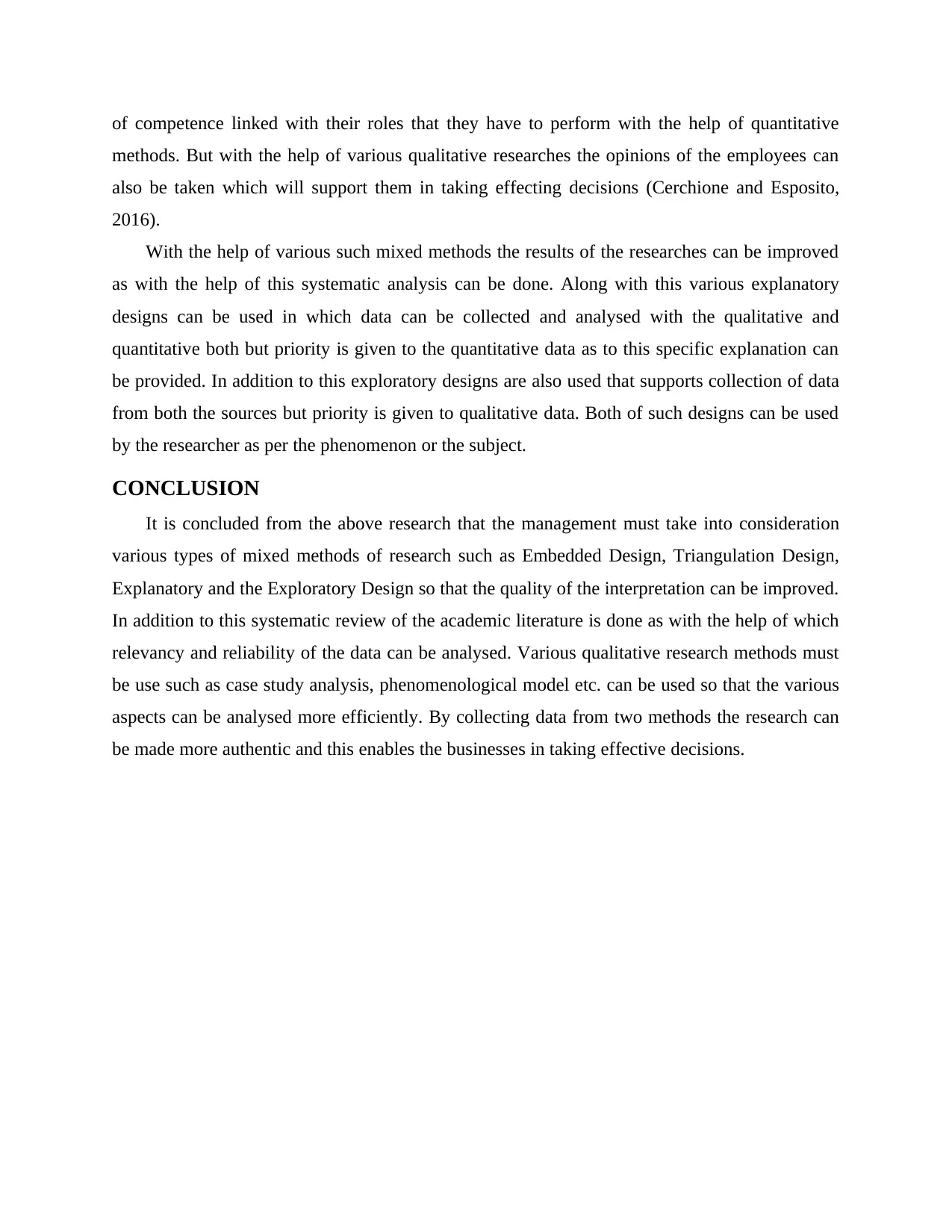
of competence linked with their roles that they have to perform with the help of quantitative
methods. But with the help of various qualitative researches the opinions of the employees can
also be taken which will support them in taking effecting decisions (Cerchione and Esposito,
2016).
With the help of various such mixed methods the results of the researches can be improved
as with the help of this systematic analysis can be done. Along with this various explanatory
designs can be used in which data can be collected and analysed with the qualitative and
quantitative both but priority is given to the quantitative data as to this specific explanation can
be provided. In addition to this exploratory designs are also used that supports collection of data
from both the sources but priority is given to qualitative data. Both of such designs can be used
by the researcher as per the phenomenon or the subject.
CONCLUSION
It is concluded from the above research that the management must take into consideration
various types of mixed methods of research such as Embedded Design, Triangulation Design,
Explanatory and the Exploratory Design so that the quality of the interpretation can be improved.
In addition to this systematic review of the academic literature is done as with the help of which
relevancy and reliability of the data can be analysed. Various qualitative research methods must
be use such as case study analysis, phenomenological model etc. can be used so that the various
aspects can be analysed more efficiently. By collecting data from two methods the research can
be made more authentic and this enables the businesses in taking effective decisions.
methods. But with the help of various qualitative researches the opinions of the employees can
also be taken which will support them in taking effecting decisions (Cerchione and Esposito,
2016).
With the help of various such mixed methods the results of the researches can be improved
as with the help of this systematic analysis can be done. Along with this various explanatory
designs can be used in which data can be collected and analysed with the qualitative and
quantitative both but priority is given to the quantitative data as to this specific explanation can
be provided. In addition to this exploratory designs are also used that supports collection of data
from both the sources but priority is given to qualitative data. Both of such designs can be used
by the researcher as per the phenomenon or the subject.
CONCLUSION
It is concluded from the above research that the management must take into consideration
various types of mixed methods of research such as Embedded Design, Triangulation Design,
Explanatory and the Exploratory Design so that the quality of the interpretation can be improved.
In addition to this systematic review of the academic literature is done as with the help of which
relevancy and reliability of the data can be analysed. Various qualitative research methods must
be use such as case study analysis, phenomenological model etc. can be used so that the various
aspects can be analysed more efficiently. By collecting data from two methods the research can
be made more authentic and this enables the businesses in taking effective decisions.
⊘ This is a preview!⊘
Do you want full access?
Subscribe today to unlock all pages.

Trusted by 1+ million students worldwide
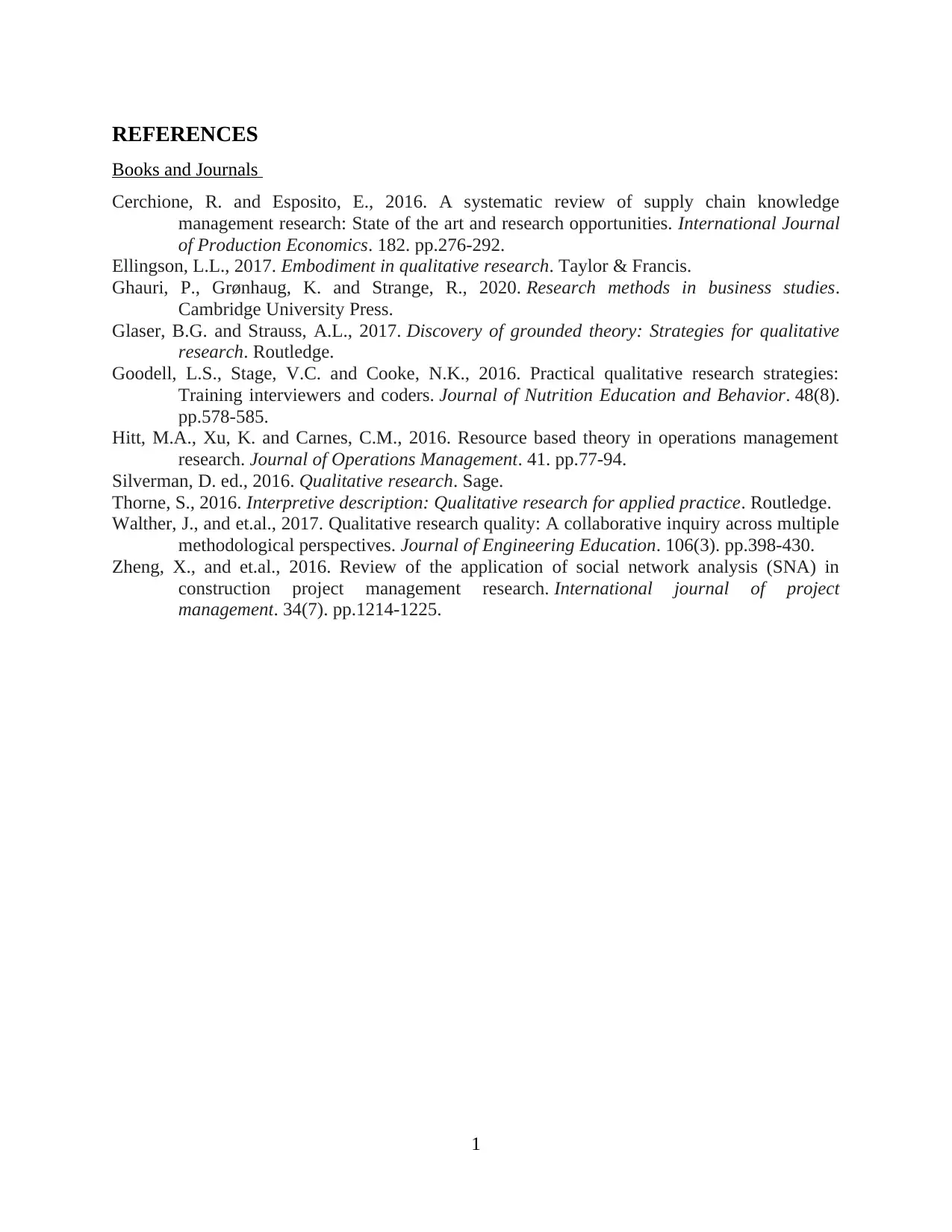
REFERENCES
Books and Journals
Cerchione, R. and Esposito, E., 2016. A systematic review of supply chain knowledge
management research: State of the art and research opportunities. International Journal
of Production Economics. 182. pp.276-292.
Ellingson, L.L., 2017. Embodiment in qualitative research. Taylor & Francis.
Ghauri, P., Grønhaug, K. and Strange, R., 2020. Research methods in business studies.
Cambridge University Press.
Glaser, B.G. and Strauss, A.L., 2017. Discovery of grounded theory: Strategies for qualitative
research. Routledge.
Goodell, L.S., Stage, V.C. and Cooke, N.K., 2016. Practical qualitative research strategies:
Training interviewers and coders. Journal of Nutrition Education and Behavior. 48(8).
pp.578-585.
Hitt, M.A., Xu, K. and Carnes, C.M., 2016. Resource based theory in operations management
research. Journal of Operations Management. 41. pp.77-94.
Silverman, D. ed., 2016. Qualitative research. Sage.
Thorne, S., 2016. Interpretive description: Qualitative research for applied practice. Routledge.
Walther, J., and et.al., 2017. Qualitative research quality: A collaborative inquiry across multiple
methodological perspectives. Journal of Engineering Education. 106(3). pp.398-430.
Zheng, X., and et.al., 2016. Review of the application of social network analysis (SNA) in
construction project management research. International journal of project
management. 34(7). pp.1214-1225.
1
Books and Journals
Cerchione, R. and Esposito, E., 2016. A systematic review of supply chain knowledge
management research: State of the art and research opportunities. International Journal
of Production Economics. 182. pp.276-292.
Ellingson, L.L., 2017. Embodiment in qualitative research. Taylor & Francis.
Ghauri, P., Grønhaug, K. and Strange, R., 2020. Research methods in business studies.
Cambridge University Press.
Glaser, B.G. and Strauss, A.L., 2017. Discovery of grounded theory: Strategies for qualitative
research. Routledge.
Goodell, L.S., Stage, V.C. and Cooke, N.K., 2016. Practical qualitative research strategies:
Training interviewers and coders. Journal of Nutrition Education and Behavior. 48(8).
pp.578-585.
Hitt, M.A., Xu, K. and Carnes, C.M., 2016. Resource based theory in operations management
research. Journal of Operations Management. 41. pp.77-94.
Silverman, D. ed., 2016. Qualitative research. Sage.
Thorne, S., 2016. Interpretive description: Qualitative research for applied practice. Routledge.
Walther, J., and et.al., 2017. Qualitative research quality: A collaborative inquiry across multiple
methodological perspectives. Journal of Engineering Education. 106(3). pp.398-430.
Zheng, X., and et.al., 2016. Review of the application of social network analysis (SNA) in
construction project management research. International journal of project
management. 34(7). pp.1214-1225.
1
1 out of 10
Related Documents
Your All-in-One AI-Powered Toolkit for Academic Success.
+13062052269
info@desklib.com
Available 24*7 on WhatsApp / Email
![[object Object]](/_next/static/media/star-bottom.7253800d.svg)
Unlock your academic potential
Copyright © 2020–2025 A2Z Services. All Rights Reserved. Developed and managed by ZUCOL.





